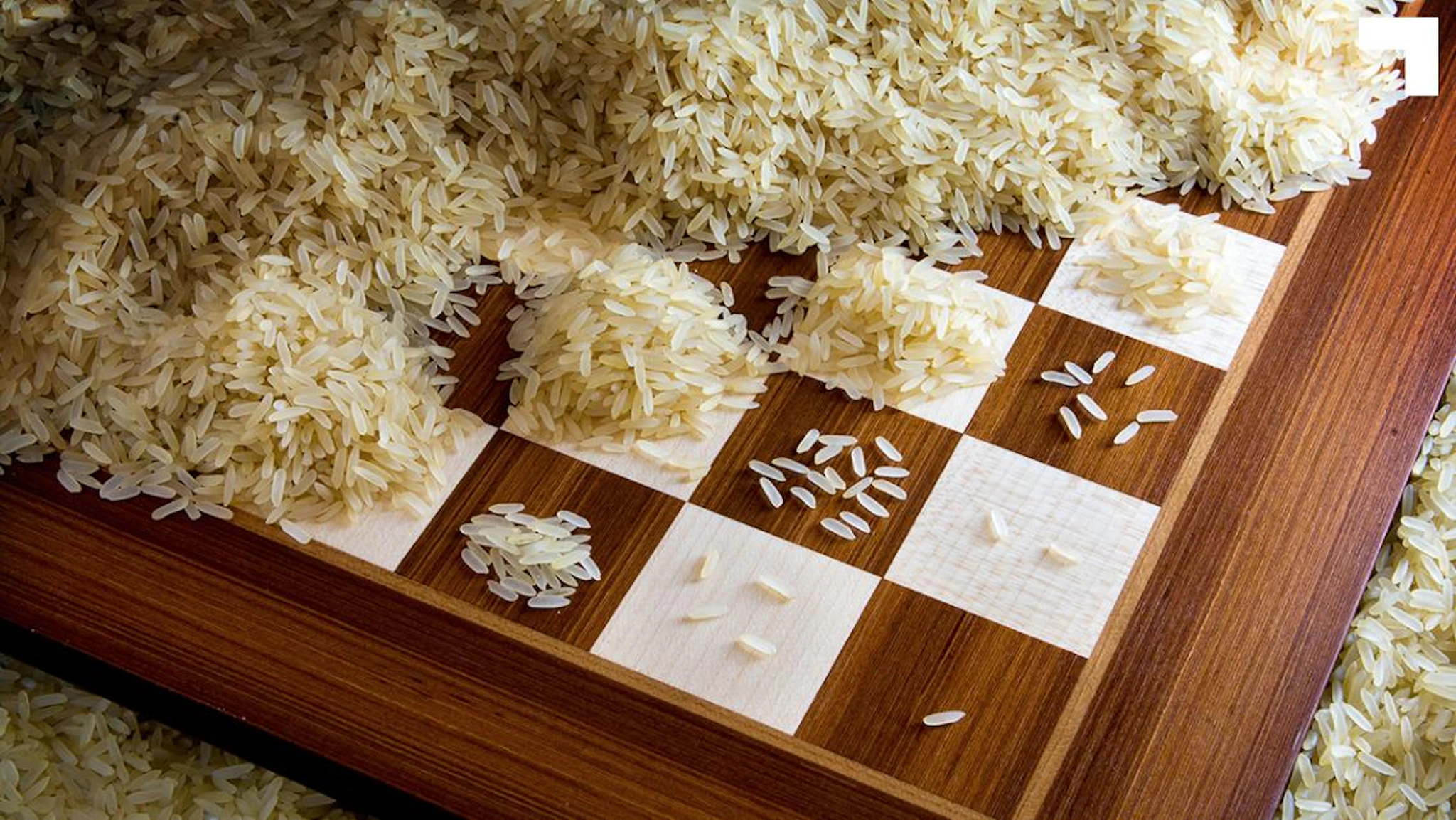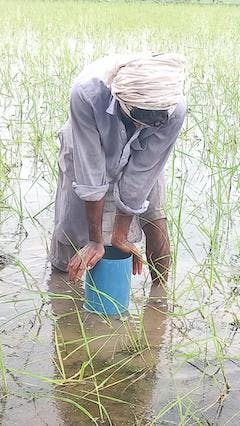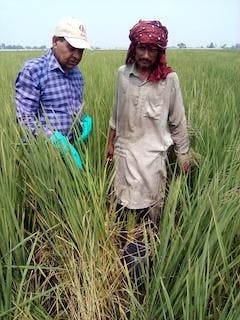Rice is the world’s most important staple food crop, helping feed over four billion people. However, the grain highlights the central paradox of food production: feeding the world’s growing population is also polluting our earth, making us more vulnerable to climate change.

The most productive rice farming currently requires the flooding of paddy fields, consuming vast quantities of water. It also creates a low oxygen environment, leading to soil microbes producing methane that escapes from the water into the atmosphere.
Methane is a potent greenhouse gas (GHG), with a global warming potential 28 times greater than carbon dioxide. Over the past two years, scientists have observed record annual increases in atmospheric levels of methane(1). Rice cultivation is responsible for around 14% of those methane emissions, which is more than the GHG footprint of the entire aviation industry.
There are simple steps we can take to reduce methane emissions from rice production. Nevertheless, most of the world’s rice is produced by around 140 million smallholders in Asia, who predominantly exist at subsistence level. This means that innovations to farming practices need to be low-cost, easy to implement and have a positive impact on yield.
Innovative Production Practices
One example of a sustainable production practice is Alternate Wetting and Drying (AWD), which involves periodically draining rice fields, rather than keeping them continuously flooded. In reducing the amount of time that soils are flooded, farmers are able to decrease the methane produced by microbes.
Numerous studies have found that AWD can cut methane emissions from rice fields by as much as 50%, reduce water use by up to 30%, improve soil health and reduce the need for chemical fertilisers(2). It is also simple and cost-effective and does not require significant changes to farming practices. Therefore, it improves both the environmental and financial sustainability of rice farming.

"The most valuable resource in our community is water. We want our future generations to have access to fresh water, like we have had, so we must make sure all the farmers in our community learn about this technique, save water, and improve their crop production." said Sajid Ali, a rice farmer in Pakistan.
Driving Change at Scale
Yet, new farming methods are not enough. We also need to incentivise farmers to make changes, particularly if those changes require upfront investment. Waving the environmental banner simply does not work unless clear economic benefits can be demonstrated to farmers.
However, there have been few incentives for farmers to embrace new practices. The Sustainable Rice Platform (SRP) provides the first framework to help smallholder rice farmers reduce their methane emissions and improve the sustainable production of rice.
NetZeroAg, a sustainable rice farming pioneer and SRP founding member, is partnering with Mars Food, the makers of Ben’s Original™ rice to invest time and effort into finding viable ways for rice farmers to be more efficient. Together, they have started working in Pakistan and are now ready to expand across Asia.
Luc Beerens, Global Sustainable Sourcing Director at Mars commented, “We have been working with NetZeroAg in Pakistan for more than a decade, successfully addressing quality, farmer income, efficient water use, and reducing methane emissions, in our Basmati supply chain. This new initiative is helping to drive change at scale, positively impacting both the environment and farmers’ livelihoods.”
NetZeroAg is developing sustainable rice production systems, as well as providing social services previously unavailable to most smallholder rice farmers. It works with smallholders throughout Asia to create tools that quantify methane reduction, with the ethos that you cannot change what you cannot measure.
Previously, measuring methane was hugely expensive and time-consuming, requiring the use of in-field scientific methods. However, new technology now uses remote sensing, automated sensors and satellite data to provide accurate, low-cost real-time data on methane emissions. On top of that, sensors can be used to monitor other important agricultural parameters, such as crop growth, soil moisture and water usage. Farmers are then able to use that data to improve the efficiency of their irrigation systems and optimise other mitigation practices.
“This effort is the culmination of decades of work by the global rice science community. To see our work finally making a significant impact on farmers’ lives is enormously gratifying.”
said Dr Robert Zeigler, former Director General of the International Rice Research Institute (IRRI) and SRP Board Member
Maximising Impact through Corporate Finance
Companies are increasingly being expected to abate their own value chain emissions and to take responsibility for ongoing emissions while they do so. And they are also being held to account for their impact on nature.

According to emissions accounting good practices, such as the Greenhouse Gas Protocol, companies that purchase rice and related products should include the associated emissions within their Scope 3 inventories and their science-based targets. This creates the incentive to invest in reducing those emissions through procurement choices and ‘interventions’ that target the reduction and removal of emissions. There are numerous challenges to investing in supply chains, including traceability, data access, capacity and a need for collective action. Through its own certification, as well as the Value Change Initiative and newly launched AIM Platform, Gold Standard has pioneered approaches to Scope 3 investments.
Companies taking responsibility for ongoing emissions represents an opportunity for others in their value chain. Notably, this is paving the way for farmers to benefit from carbon credits.
Methodological Controversy
It is clear that the world urgently needs action to reduce the impact that rice farming has on the planet. Selling carbon credits on the Voluntary Carbon Market is one way we can incentivise the changes that we need.
New technology is providing data to generate credits which help to incentivise smallholder farmers to act more sustainably. NetZeroAg has set up a carbon credit scheme verified by Gold Standard as part of its work in the rice sector. Gold Standard is investigating new rice-specific tools and measurement, reporting and verification approaches. It is also developing new financing schemes based on companies addressing their Scope 3 emissions and emerging nature targets. At NetZeroAG we welcome Gold Standard’s leadership in revising this methodology and their deep engagement with the scientific community in the rice sector.
Today, these carbon credits are making a material difference to rice farmers’ lives, with their incomes projected to double. The scheme provides additional sustainable development impacts to communities, from health to training and welfare support.
It is clear that this is a win-win-win situation for farmers, consumers and our planet. Farmers are able to improve their livelihoods and access tools to improve their farming methods. This in turn means that consumers can continue to eat the food they need, and finally, we are safe with the knowledge that this is doing less harm to our planet.
- (1) U.S. Department of Commerce, National Oceanic and Atmospheric Administration, “Increase in atmospheric methane set another record during 2021.” 2022
- (2) Carrijo, Daniela R., Linquist, Bruce A. and Lundy, Mark E., “Rice yields and water use under alternate wetting and drying irrigation: A meta-analysis.” Field Crops Research, vol. 203, 2017, 173-180
- Chidthaisong, Amnat et al.,”Evaluating the effects of alternate wetting and drying (AWD) on methane and nitrous oxide emissions from a paddy field in Thailand." Soil Science and Plant Nutrition, vol. 64, 2017, 1-8
- International Rice Research Institute (IRRI), “GHG Mitigation in Rice: Alternate Wetting and Drying.” 2019
- Runkle, Benjamin R. K., et al., “Methane Emission Reductions from the Alternate Wetting and Drying of Rice Fields Detected Using the Eddy Covariance Method." Environmental Science & Technology, 2019 53 (2), 671-681
- Haomiao, Cheng et al., “Effects of alternate wetting and drying irrigation on yield, water and nitrogen use, and greenhouse gas emissions in rice paddy fields.” Journal of Cleaner Production, vol. 349, 2022
